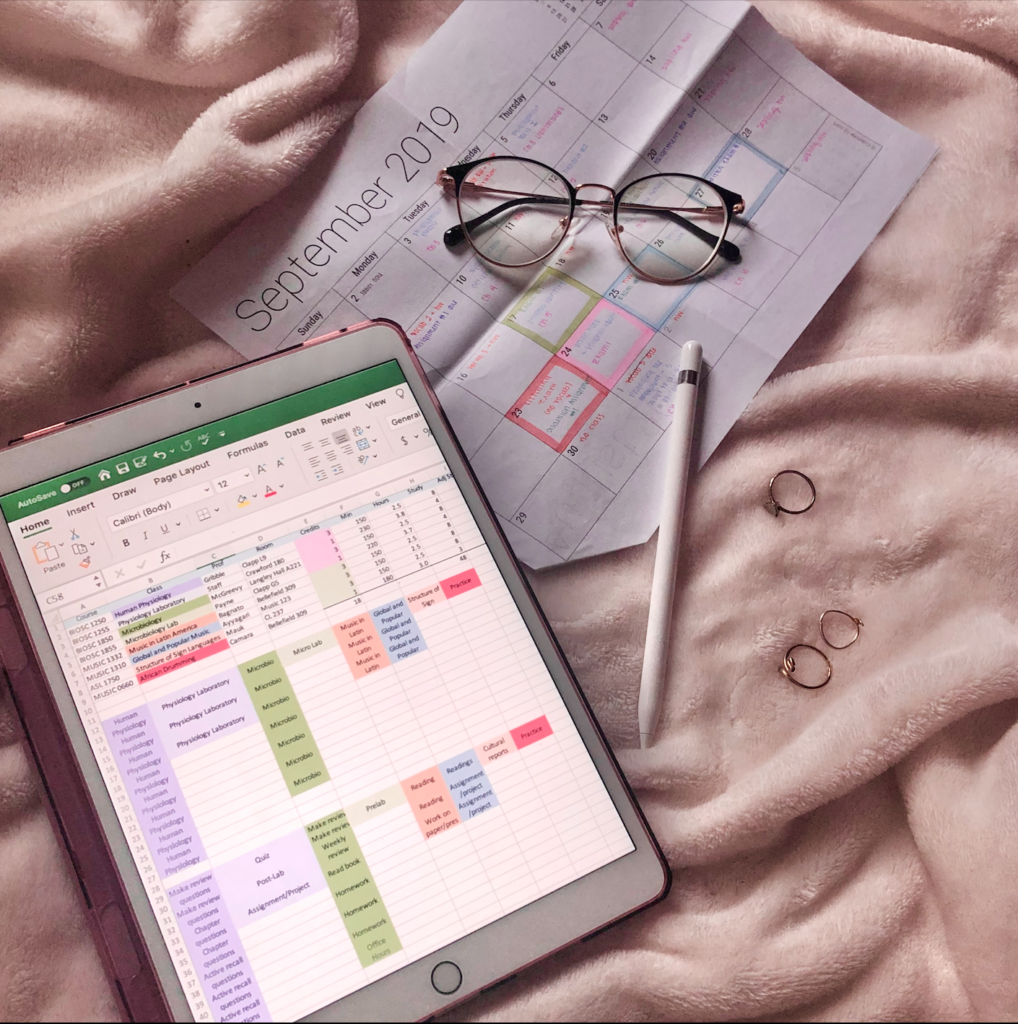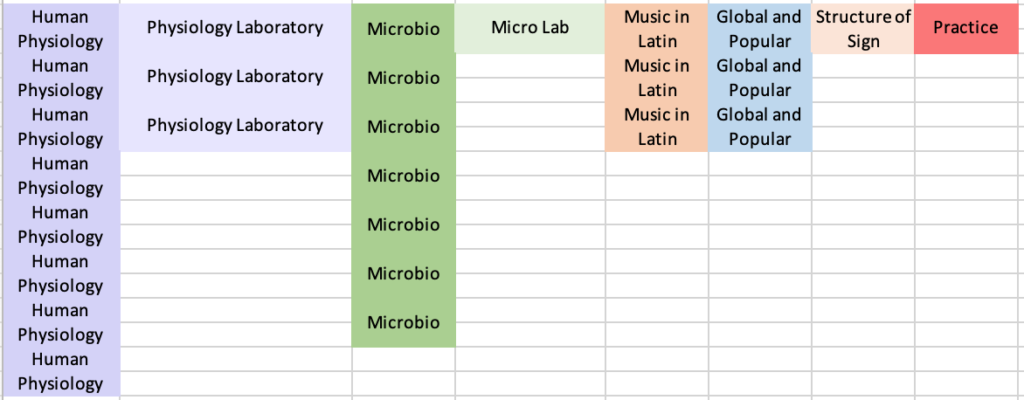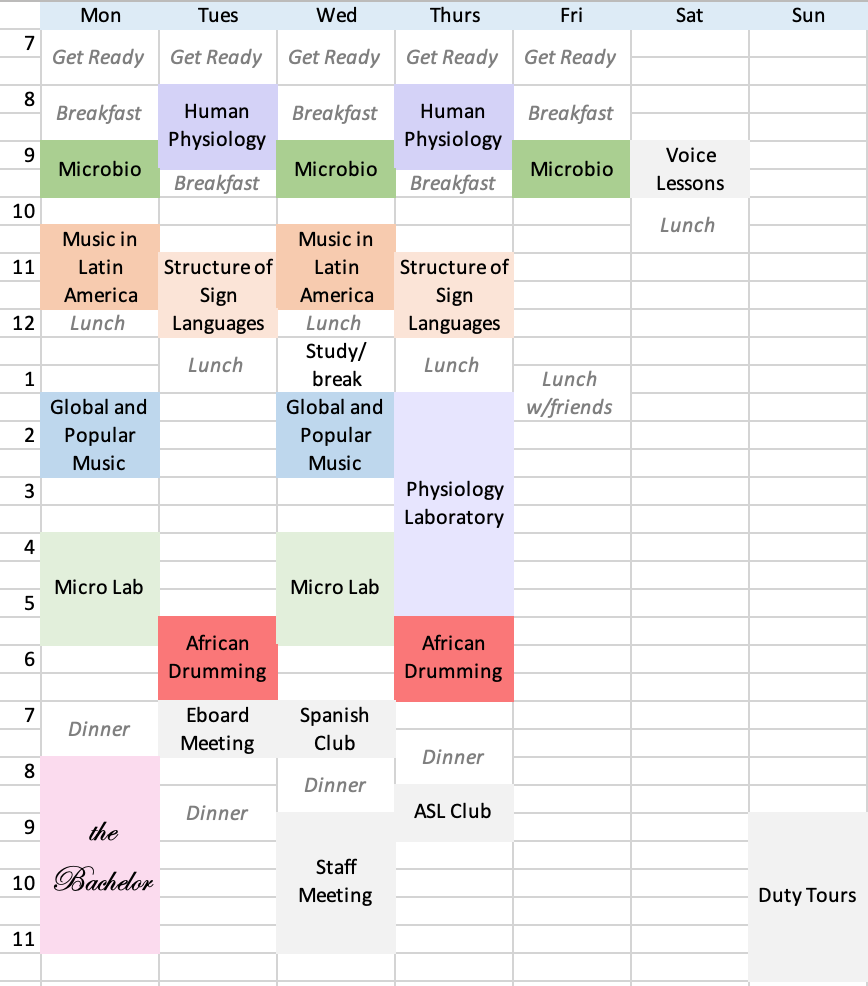Time management is an invaluable skill for any college student. Planning out your time will help you balance your clubs, homework, classes, and work — while still leaving time for some fun.

Typically, I took between 18-20 credits, worked as a Resident Assistant, served as a Board Member for my clubs, applied for scholarships, and still had time for a weekly face mask and lunch with my friends. So, yeah, I guess you can say that I’ve got this time management thing figured out.
I’ve broken down my time management technique step-by-step (with pictures!), so you can make the most of your time, too!
Make a List of Your Classes
Personally, I use Microsoft Excel for my scheduling, but you can use any grid-like program.
- Create a table with the following columns. Items with a star (*) are required, while the others are just helpful to have.
- Course number
- Class name*
- Credits*
- Minutes in class per week
- Hours in class per week*
- Calculated weekly study hours*
- Adjusted weekly study hours*
- Fill in the course, class, credits, and minutes/hours in class per week for each of your classes.
- For each class, assign it a color that you can remember. If you’d like, you can also color code by difficulty. I used red for hard classes and green for easy classes (see picture below).
Calculate Your Study Hours
- Your study hours = credits x hours in class per week. This will give you an estimate of how many hours you should be studying for that class.
- Adjust your study hours. Again, the calculated number is an ESTIMATE. Generally, if I know a class will be easy, I’ll reduce the number of hours per week. Or, if it’s hard, I might increase my study hours. Fill these new values in your adjusted hours column.
- If you don’t know how difficult a class will be for you, just use the same numbers as the calculated study hours
At this point, you should have something that looks like this:

Make Hour-Long Time Blocks
Using the colors you assigned for each class, make blocks with the class name. The number of blocks for each class should equal your adjusted study hours for each class.
- ex. I had 8 adjusted study hours for Human Physiology, so I made 8 blocks
This is what mine looks like:

(Optional: if you have more information about your classes from your syllabi, you can put in actual assignments instead of the class name)
Make a Time Table
- Make a time table (Monday-Sunday) starting from when you wake up to when you go to bed.
- Put your class times into your schedule
- Put your clubs and weekly meetings into your schedule
- Give yourself time for 3 meals a day. Ideally, you should schedule at least one hour for each meal.Hot take: if you don’t have time to eat or sleep, then you aren’t managing your time well.
- Personally, I eat in about 15 minutes, so my meals give me 45 minutes of free time. When you plan each hour of your day, you need wiggle room for unexpected events like mail deliveries, sudden meetings, super long lines in the cafeteria, or just some downtime.
- Add times for exercise, your favorite shows, or weekly meetups with friends. Self-care is just as important as your classes!
My schedule now looks like this (and yes — I did schedule in time to watch the Bachelor):

Add Study times
You’re almost done!
Just copy and paste your study blocks you made for each class into your open time slots! I greyed out my in-class times for clarity.
Now my schedule looks like:

Adjust Your Schedule
Your study schedule may not be perfect on the first try. Maybe you’ll realize that you don’t like studying for a class at a certain time, or maybe there are too many study hours in one day. Take about a week to shift things around and find what works for you.
And that’s it! Planning my time this way made my days so easy because everything was part of a routine. Even my grades went up because I was spending the right amount of time on every class! Now, get planning!
⭐️⭐️⭐️⭐️⭐️
If you want some tips on how I study effectively for my pre-health science courses, check out my post here!

